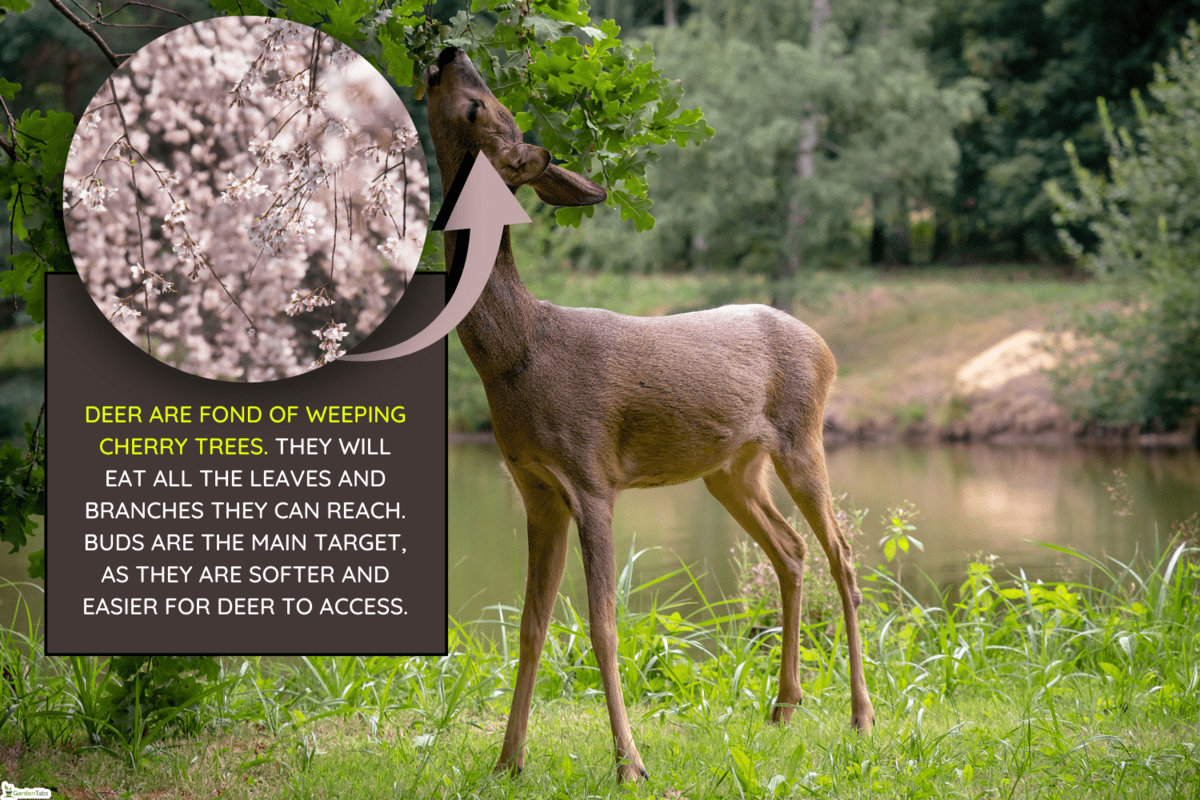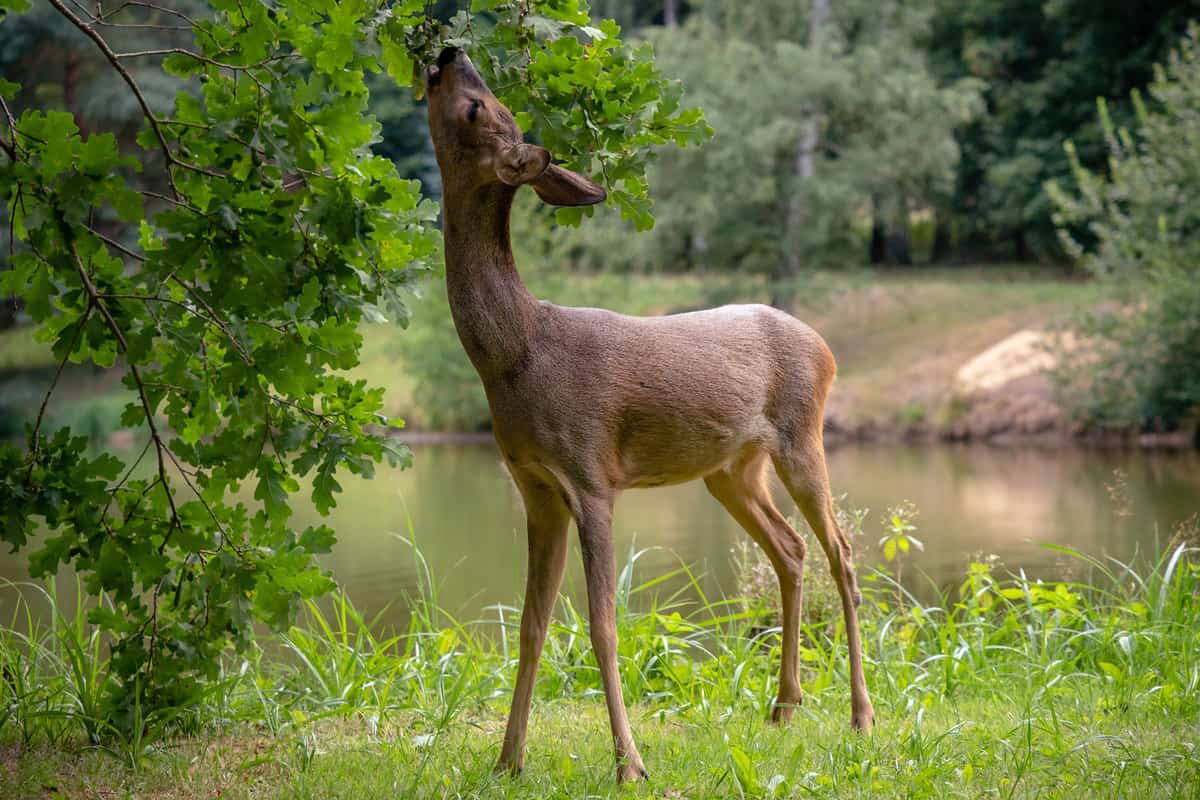Weeping cherry trees are a sight to behold. If you have one in your yard and suspect that something could be eating its leaves, you can't take action unless you know who the culprit is. Could it be a deer? With our research, we will answer your questions in this post. Read on!
Deer are fond of weeping cherry trees. They will eat all the leaves and branches they can reach. Buds are the main target, as they are softer and easier for deer to access.
Deer like eating different types of trees and plants, which can be a nuisance. How can you keep them away from your weeping cherry tree? We will teach you about some of the other things that deer like to eat and how to stop them from bothering your weeping cherry tree. Keep reading to learn more!

Do Deer Eat Cherry Trees?
Since deer are herbivores, they may stake out your garden for anything they can eat. They enjoy most types of fruit, so they love weeping cherry trees. They will eat whatever they can reach, from the leaves to the flowers and branches.
The tree is an easy target for deer because of how close its foliage is to the ground. It's usually at least six inches above the ground, so it's very accessible. The average deer is around three feet tall.

The point that deer can reach for eating is called a browse line. It is not hard to spot one on your tree if deer have been nibbling on it. You can quickly tell that they are the culprits if you spot the browse line at around three feet or a little higher.
Deer will eat your weeping cherry tree if it is accessible. Food may be hard to come by in your area, so your garden could become their feeding ground if you are not careful.
Do Deer Eat Fruit Trees?

A deer's diet is filled with plants. They will eat any vegetation, including different crops and nuts. Deer will eat six to eight percent of their body weight in foliage daily.
While deer are fond of crops, especially corn, they will also eat from several types of fruit trees. Aside from the weeping cherry tree, deer will eat apples, pears, plums, and persimmons. Deer will eat the fruit and woody leaves and stems from these trees.
Fruit trees are a good source of nutrition for deer. The fruit also tastes good to them. Some deer even prefer certain trees over others!
As long as your tree is healthy, it will survive with damage from deer. You should address any problems with deer before they get out of hand and allow your trees time to regrow.
You should be alarmed, however, if the deer in your area are stripping off the tree bark. The bark will not grow back, and this can cause irreversible damage to your tree.
An exposed tree trunk is prone to injury and disease. The tree will also have trouble transporting nutrients up the trunk.
How To Tell If A Deer Is Eating Your Trees

Aside from the height of the browse line, you can identify deer damage in other ways.
Observe how leaves and branches are torn off your plants. Deer teeth are formed in such a way that they need to pull and tear at the leaves to eat them. Keep an eye out for jagged edges as opposed to clean cuts for deer bites.
If deer have been stripping your tree bark, they can also cause damage with their antlers. Male deer or bucks are capable of causing damage up to six feet high on trees due to this.
You are likely to have deer eating your plants if your area is a known deer hotspot. While other animals like rodents will also target your plants, deer create a wider range of noticeable damage due to their size.
Deer leave bigger traces compared to other foraging animals. Most notable are their footprints.
You can look around your vicinity to spot any deer tracks. They come in different sizes, but the standard shape is pointed and two hoofed toes. They are between one to four inches long and .75 to 2.8 inches wide.
Weeping Cherry Tree Alternatives
If you are considering adding a weeping cherry tree to your yard but are concerned about attracting deer, then you should consider some alternatives.
You do not have to sacrifice the aesthetics of a weeping cherry tree since there are trees of other varieties that can achieve the same effect. Instead, you can opt for weeping birch, weeping European beech, or weeping white pines, among others.
Deer don't like these trees as much as weeping cherry trees because of the fruit. You can also plant trees that have an unpleasant taste or smell to keep deer away.
Which Plants Are Deer Resistant?

If you want color in your garden similar to that from a cherry tree, there are quite a few deer-resistant flowering shrubs you can add.
As we mentioned, you can repel deer with plants that have strong or unpleasant odors. Deer have a sense of smell that is a thousand times stronger than that of humans, so you can get flowering shrubs that may be pleasant to you but unpleasant to deer.
Lavender, daffodil, iris, digitalis, and butterfly bush are examples of flowers that you can grow without worrying about deer. Some of these plants, such as daffodil, are toxic. Poppies and foxgloves are also toxic. Prickly plants will also keep deer out.
There may be times when you find deer eating plants that are supposed to be deer-resistant. When this happens, you may have to resort to other methods for keeping them away.
How To Keep Deer From Eating Cherry Trees

When you really can't control problems with deer getting into your garden or eating your trees, then it is time to resort to other methods. Rather than planting deer-resistant plants, you can set up a fence that will keep the deer out.
Building a fence is the most secure way of keeping deer out. Ideally, your yard or garden should already be fenced off. Take note that deer can jump over fences, so you must build the fence in such a way that makes it hard for them to do so.
Fences should be five to six feet tall. You can also individually fence up younger trees so that they have time to grow before deer eat them, You can eventually remove the fence once the tree is mature enough.
Alternatively, you can cover your younger trees and saplings in mesh nets made to keep them protected. Nylon netting, burlap, wire cages, and tree wrap are all solutions to keep deer away from young trees.
Adding herbs and smelly plants, or spiky plants around your garden perimeter can make it less appealing for deer, as well. Deer-repellent shrubs such as juniper, arrowwood, and boxwood can be high enough to keep deer out.
You can also track the paths deer take to your garden and make the ground uneven. If it is not a hazard to you, then you may even spread wire fencing on the ground.
For other repellent methods, try spreading soap around your yard. The smell is guaranteed to keep deer away.
You can even try scaring them off, but this will only work if you are around when they are. Try setting up wind chimes or using decor that will spook any deer that ventures into your yard.
Deer are known to dislike egg-based products. You can use egg-based repellants in this case. Another natural repellant is vinegar, which you can spray around your garden. This will repel deer and other trespassing animals.
Finally, you can resort to commercial deer repellent.
Click here to see this deer repellent spray on Amazon.
This repellant can come as liquid in gallons or in spray bottles. Many of them, including the products featured here, are safe for use around pets and children.
Click here to see this deer repellent on Amazon.
Wrapping Things Up
Deer will eat weeping cherry trees. They will eat anything from the tree and are especially attracted to trees with fruit. Since the foliage on weeping cherry trees is low to the ground, it is easy for deer to reach.
You can keep deer away by either planting deer-resistant alternatives or using deer repellent around your garden. At times, deer may eat deer-resistant plants, so that is something to keep an eye out for as well.
Did you find this post helpful? If you did, check out our other posts before you go!


